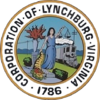Lynchburg, Va.
| Lynchburg, Virginia | |||||
|---|---|---|---|---|---|
| Independent city | |||||
| City of Lynchburg | |||||

The downtown Lynchburg skyline in the late 2000s
|
|||||
|
|||||
| Nickname(s): "The Hill City"; "City of Seven Hills" | |||||
 Location within the Commonwealth of Virginia |
|||||
| Location within the contiguous United States of America | |||||
| Coordinates: 37°24′13″N 79°10′12″W / 37.40361°N 79.17000°WCoordinates: 37°24′13″N 79°10′12″W / 37.40361°N 79.17000°W | |||||
| Country |
|
||||
| State |
|
||||
| Founded | 1786 | ||||
| Incorporated (town) | 1805 | ||||
| Incorporated (city) | 1852 | ||||
| Named for | John Lynch | ||||
| Government | |||||
| • Type | Council–Manager | ||||
| • Mayor | Joan Foster | ||||
| • Vice Mayor | Treney Tweedy | ||||
| • Council | Lynchburg City Council | ||||
| Area | |||||
| • Independent city | 128 km2 (49.6 sq mi) | ||||
| • Land | 127 km2 (49.1 sq mi) | ||||
| • Water | 1 km2 (0.5 sq mi) | ||||
| Elevation | 192 m (630 ft) | ||||
| Population (2016) | |||||
| • Independent city | 80,212(US: 416th) | ||||
| • Density | 594/km2 (1,539/sq mi) | ||||
| • Urban | 116,636 (US: 271st) | ||||
| • Metro | 260,320 (US: 184th) | ||||
| • Demonym | Lynchburgian, Lynchburger | ||||
| Time zone | EST (UTC-5) | ||||
| • Summer (DST) | EDT (UTC-4) | ||||
| ZIP code(s) | 24501, 24502, 24503, 24504, 24551 | ||||
| Area code(s) | 434 | ||||
| FIPS code | 51-47672 | ||||
| GNIS feature ID | 1479007 | ||||
| Major airport | LYH | ||||
| Website | lynchburgva |
||||
Lynchburg is an independent city in the Commonwealth of Virginia. As of the 2010 census, the population was 75,568. The 2016 census estimates an increase to 80,212. Located in the foothills of the Blue Ridge Mountains along the banks of the James River, Lynchburg is known as the "City of Seven Hills" or the "Hill City". In the 1860s, Lynchburg was the only major city in Virginia that was not recaptured by the U.S. before the end of the American Civil War.
Lynchburg is the principal city of the Metropolitan Statistical Area of Lynchburg, near the geographic center of Virginia. It is the fifth largest MSA in Virginia with a population of 260,320 and hosts several institutions of higher education. Other nearby cities include Roanoke, Charlottesville, and Danville.
Monacan people and other Siouan Tutelo-speaking tribes had lived in the area since at least 1270, well before English settlers arrived in Virginia. They had driven the Virginia Algonquians eastward. Explorer John Lederer visited one of the Siouan villages (Saponi) in 1670, on the Staunton River at Otter Creek, southwest of the present-day city, as did the Thomas Batts and Robert Fallam expedition in 1671. Siouans occupied the area until about 1702, when, weakened by illness, the Seneca people (who spoke an Iroquois-related language) and hunted along the Shenandoah valley to the West conquered them. Beginning in 1718, certain Iroquois ceded control to the Colony of Virginia, as later did others at the Treaty of Albany in 1721 and Treaty of Lancaster in 1744.
...
Wikipedia




